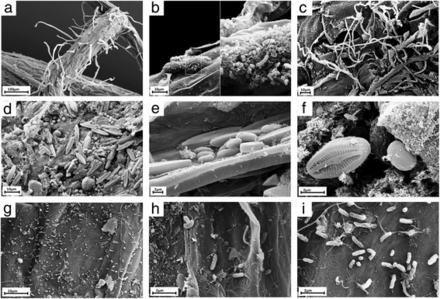Microbial consortium
A microbial consortium is two or more microbial groups living symbiotically.[2][3] Consortiums can be endosymbiotic or ectosymbiotic.

Microbial consortia naturally formed
on the roots of Arabidopsis thaliana
Scanning electron microscopy pictures of root surfaces from natural A. thaliana populations showing the complex microbial networks formed on roots.on the roots of Arabidopsis thaliana
a) Overview of an A. thaliana root (primary root) with numerous root hairs. b) Biofilm-forming bacteria. c) Fungal or oomycete hyphae surrounding the root surface. d) Primary root densely covered by spores and protists. e, f) Protists, most likely belonging to the Bacillariophyceae class. g) Bacteria and bacterial filaments. h, i) Different bacterial individuals showing great varieties of shapes and morphological features.[1]
The concept of consortium was first introduced by Johannes Reinke in 1872.[4][5] The term preceded to the term symbiosis that was introduced into biology some years later.
Notes
- Hassani, M.A., Durán, P. and Hacquard, S. (2018) "Microbial interactions within the plant holobiont". Microbiome, 6(1): 58. doi:10.1186/s40168-018-0445-0.

- Clark, D.P., Dunlap, P.V., Madigan, M.T., Martinko, J.M. Brock, Biology of Microorganisms. San Francisco: Pearson; 2009. p. 485.
- Mark, Martin (2009-04-27). "Happy Together… Life of the Bacterial Consortium Chlorochromatium aggregatum". Small Things Considered - The Microbe Blog. American Society for Microbiology. Archived from the original on 2009-05-01. Retrieved 2012-01-11.
Consortia are assemblages of different species of microbes in physical (and sometimes intricate biochemical) contact with one another, and are implicated in biological processes ranging from sewage treatment to marine nitrogen cycling to metabolic processes within the rumen.
- Reinke, Johannes 1872. Ueber die anatomischen Verhältnisse einiger Arten von Gunnera L. Nachrichten von der Königl. Gesellschaft der Wissenschaften und der Georg-Augusts-Universität zu Göttingen 9: 100–108.
- Kull, Kalevi 2010. Ecosystems are made of semiosic bonds: Consortia, umwelten, biophony and ecological codes. Biosemiotics 3(3): 347–357.
This article is issued from Wikipedia. The text is licensed under Creative Commons - Attribution - Sharealike. Additional terms may apply for the media files.